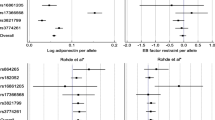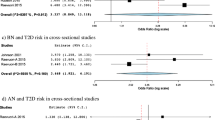Abstract
Purpose
To elucidate the possible role of adiponectin, an adipokine secreted by white adipose tissue that plays an important role in the neuromodulation of food intake, in the pathogenesis of eating disorders.
Methods
A comprehensive review of the available literature via MedLine is done using the term “adiponectin” in association with one of the following terms: “anorexia nervosa”, “bulimia nervosa”, “binge eating disorder” or “eating disorders”.
Results
The majority of studies evaluating serum adiponectin levels in patients with eating disorders show that serum adiponectin levels are increased in patients with anorexia nervosa. After refeeding, adiponectin levels tend to rejoin the levels of healthy individuals. Data concerning serum adiponectin levels in patients with bulimia nervosa show that these levels can be equal, higher or lower than those found in healthy controls and lower than those found in anorexia nervosa patients. Binge eating disorder is accompanied with lower serum adiponectin levels than normal. Adiponectin receptor type 1 seems to be more related to the central pathological effect of adiponectin on eating behavior.
Conclusion
The potential role that plays adiponectin in the pathogenesis of eating disorders needs to be elucidated by further studies.
Similar content being viewed by others
References
Arita Y, Kihara S, Ouchi N et al (1999) Paradoxical decrease of an adipose-specific protein, adiponectin, in obesity. Biochem Biophys Res Commun 257:79–83
Scherer PE, Williams S, Fogliano M et al (1995) A novel serum protein similar to C1q, produced exclusively in adipocytes. J Biol Chem 270:26746–26749
Shapiro L, Scherer PE (1998) The crystal structure of a complement-1q family protein suggests an evolutionary link to tumor necrosis factor. Curr Biol 8:335–338
Hu E, Liang P, Spiegelman BM (1996) AdipoQ is a novel adipose-specific gene dysregulated in obesity. J Biol Chem 271:10697–10703
Kadowaki T, Yamauchi T (2005) Adiponectin and adiponectin receptors. Endocr Rev 26:439–451
Nishida M, Funahashi T, Shimomura I (2007) Pathophysiological significance of adiponectin. Med Mol Morphol 40:55–67
Matsubara M, Maruoka S, Katayose S (2002) Inverse relationship between plasma adiponectin and leptin concentrations in normal-weight and obese women. Eur J Endocrinol 147:173–180
Cnop M, Havel PJ, Utzschneider KM et al (2003) Relationship of adiponectin to body fat distribution, insulin sensitivity and plasma lipoproteins: evidence for independent roles of age and sex. Diabetologia 46:459–469
Lara-Castro C, Luo N, Wallace P et al (2006) Adiponectin multimeric complexes and the metabolic syndrome trait cluster. Diabetes 55:249–259
Yamauchi T, Kamon J, Ito Y et al (2003) Cloning of adiponectin receptors that mediate antidiabetic metabolic effects. Nature 423:762–769
Deepa SS, Dong LQ (2009) APPL1: role in adiponectin signaling and beyond. Am J Physiol Endocrinol Metab 296:E22–E36
Lindsay RS, Funahashi T, Hanson RL et al (2002) Adiponectin and development of type 2 diabetes in the Pima Indian population. Lancet 360:57–58
Brochu-Gaudreau K, Rehfeldt C, Blouin R et al (2010) Adiponectin action from head to toe. Endocrine 37:11–32
Bosy-Westphal A, Brabant G, Haas V et al (2005) Determinants of plasma adiponectin levels in patients with anorexia nervosa examined before and after weight gain. Eur J Nutr 44:355–359
Delporte ML, Brichard SM, Hermans MP et al (2003) Hyperadiponectinaemia in anorexia nervosa. Clin Endocrinol (Oxf) 58:22–29
Dolezalova R, Lacinova Z, Dolinkova M et al (2007) Changes of endocrine function of adipose tissue in anorexia nervosa: comparison of circulating levels versus subcutaneous mRNA expression. Clin Endocrinol (Oxf) 67:674–678
Dostálová I, Smitka K, Papezová H et al (2006) The role of adiponectin in increased insulin sensitivity of patients with anorexia nervosa. Vnitr Lek 52:887–890
Dostálová I, Smitka K, Papezová H et al (2007) Increased insulin sensitivity in patients with anorexia nervosa: the role of adipocytokines. Physiol Res 56:587–594
Haluzíková D, Dostálová I, Kaválková P et al (2009) Serum concentrations of adipocyte fatty acid binding protein in patients with anorexia nervosa. Physiol Res 58:577–581
Housova J, Anderlova K, Krizová J et al (2005) Serum adiponectin and resistin concentrations in patients with restrictive and binge/purge form of anorexia nervosa and bulimia nervosa. J Clin Endocrinol Metab 90:1366–1370
Housová J, Kiziová J, Anderlova K et al (2005) Serum concentrations of adiponectin in patients with restrictive and purgative subtype of mental anorexia. Cas Lek Cesk 144:278–281
Karczewska-Kupczewska M, Straczkowski M, Adamska A et al (2010) Insulin sensitivity, metabolic flexibility, and serum adiponectin concentration in women with anorexia nervosa. Metabolism 59:473–477
Krízová J, Dolinková M, Lacinová Z et al (2008) Adiponectin and resistin gene polymorphisms in patients with anorexia nervosa and obesity and its influence on metabolic phenotype. Physiol Res 57:539–546
Modan-Moses D, Stein D, Pariente C et al (2007) Modulation of adiponectin and leptin during refeeding of female anorexia nervosa patients. J Clin Endocrinol Metab 92:1843–1847
Pannacciulli N, Vettor R, Milan G et al (2003) Anorexia nervosa is characterized by increased adiponectin plasma levels and reduced nonoxidative glucose metabolism. J Clin Endocrinol Metab 88:1748–1752
Støving RK, Chen JW, Glintborg D et al (2007) Bioactive insulin-like growth factor (IGF) I and IGF-binding protein-1 in anorexia nervosa. J Clin Endocrinol Metab 92:2323–2329
Terra X, Auguet T, Aguera Z et al (2013) Adipocytokine levels in women with anorexia nervosa. Relationship with weight restoration and disease duration. Int J Eat Disord. doi:10.1002/eat.22166
Alberti L, Gilardini L, Girola A et al (2007) Adiponectin receptors gene expression in lymphocytes of obese and anorexic patients. Diabetes Obes Metab 9:344–349
Nogueira JP, Maraninchi M, Lorec AM et al (2010) Specific adipocytokines profiles in patients with hyperactive and/or binge/purge form of anorexia nervosa. Eur J Clin Nutr 64:840–844
Iwahashi H, Funahashi T, Kurokawa N et al (2003) Plasma adiponectin levels in women with anorexia nervosa. Horm Metab Res 35:537–540
Miljic D, Djurovic M, Pekic S et al (2007) Glucose metabolism during ghrelin infusion in patients with anorexia nervosa. J Endocrinol Invest 30:771–775
Misra M, Miller KK, Almazan C et al (2004) Hormonal and body composition predictors of soluble leptin receptor, leptin, and free leptin index in adolescent girls with anorexia nervosa and controls and relation to insulin sensitivity. J Clin Endocrinol Metab 89:3486–3495
Misra M, Miller KK, Cord J et al (2007) Relationships between serum adipokines, insulin levels, and bone density in girls with anorexia nervosa. J Clin Endocrinol Metab 92:2046–2052
Amitani M, Asakawa A, Amitani H et al (2013) Plasma klotho levels decrease in both anorexia nervosa and obesity. Nutrition 29(9):1106–1109
Amitani H, Asakawa A, Ogiso K et al (2013) The role of adiponectin multimers in anorexia nervosa. Nutrition 29(1):203–206
Tagami T, Satoh N, Usui T et al (2004) Adiponectin in anorexia nervosa and bulimia nervosa. J Clin Endocrinol Metab 89:1833–1837
Monteleone P, Fabrazzo M, Martiadis V et al (2003) Opposite changes in circulating adiponectin in women with bulimia nervosa or binge eating disorder. J Clin Endocrinol Metab 88:5387–5391
Carnier J, Sanches PD, da Silva PL et al (2011) Obese adolescents with eating disorders: analysis of metabolic and inflammatory states. Physiol Behav 105:175–180
Woods S, D’Alessio D (2008) Central control of body weight and appetite. J Clin Endocrinol Metab 93(11 (Suppl 1)):S37–S50
Gale SM, Castracane VD, Mantzoros CS (2004) Energy homeostasis, obesity and eating disorders: recent advances in endocrinology. J Nutr 134:295–298
Guyenet S, Schwartz M (2012) Regulation of food intake, energy balance, and body fat mass: implications for the pathogenesis and treatment of obesity. J Clin Endocrinol Metab 97(3):745–755
Figlewicz D, Sipols A (2010) Energy regulatory signals and food reward. Pharmacol Biochem Behav 97(1):15–24
Qiao L, Lee B, Kinney B, Yoo H, Shao J (2011) Energy intake and adiponectin gene expression. Am J Physiol Endocrinol Metab 300(5):E809–E816
Faulconbridge L, Hayes M (2011) Regulation of energy balance and body weight by the brain: a distributed system prone to disruption. Psychiatr Clin North Am 34(4):733–745
Corwin RL, Hajnal A (2005) Too much of a good thing: neurobiology of non-homeostatic eating and drug abuse. Physiol Behav 86(1–2):5–8
Shin A, Zheng H, Berthoud H (2009) An expanded view of energy homeostasis: neural integration of metabolic, cognitive, and emotional drives to eat. Physiol Behav 97(5):572–580
Kos K, Harte AL, da Silva NF et al (2007) Adiponectin and resistin in human cerebrospinal fluid and expression of adiponectin receptors in the human hypothalamus. J Clin Endocrinol Metab 92:1129–1136
Maddineni S, Metzger S, Ocón O et al (2005) Adiponectin gene is expressed in multiple tissues in the chicken: food deprivation influences adiponectin messenger ribonucleic acid expression. Endocrinology 146:4250–4256
Wilkinson M, Brown R, Imran SA et al (2007) Adipokine gene expression in brain and pituitary gland. Neuroendocrinology 86:191–209
Fry M, Smith PM, Hoyda TD et al (2006) Area postrema neurons are modulated by the adipocyte hormone adiponectin. J Neurosci 26:9695–9702
Guillod-Maximin E, Roy AF, Vacher CM et al (2009) Adiponectin receptors are expressed in hypothalamus and colocalized with proopiomelanocortin and neuropeptide Y in rodent arcuate neurons. J Endocrinol 200:93–105
Kubota N, Yano W, Kubota T et al (2007) Adiponectin stimulates AMP-activated protein kinase in the hypothalamus and increases food intake. Cell Metab 6:55–68
Berg AH, Combs TP, Du X et al (2001) The adipocyte-secreted protein Acrp30 enhances hepatic insulin action. Nat Med 7:947–953
Yamauchi T, Kamon J, Waki H et al (2001) The fat-derived hormone adiponectin reverses insulin resistance associated with both lipoatrophy and obesity. Nat Med 7:941–946
Shklyaev S, Aslanidi G, Tennant M et al (2003) Sustained peripheral expression of transgene adiponectin offsets the development of diet-induced obesity in rats. Proc Natl Acad Sci USA 100:14217–14222
Tomas E, Tsao TS, Saha AK et al (2002) Enhanced muscle fat oxidation and glucose transport by ACRP30 globular domain: acetyl-CoA carboxylase inhibition and AMP-activated protein kinase activation. Proc Natl Acad Sci USA 99:16309–16313
Qi Y, Takahashi N, Hileman SM et al (2004) Adiponectin acts in the brain to decrease body weight. Nat Med 10:524–529
Coope A, Milanski M, Araújo EP et al (2008) AdipoR1 mediates the anorexigenic and insulin/leptin-like actions of adiponectin in the hypothalamus. FEBS Lett 582:1471–1476
Brichard SM, Delporte ML, Lambert M (2003) Adipocytokines in anorexia nervosa: a review focusing on leptin and adiponectin. Horm Metab Res 35:337–342
Kern PA, Di Gregorio GB, Lu T et al (2003) Adiponectin expression from human adipose tissue: relation to obesity, insulin resistance, and tumor necrosis factor-alpha expression. Diabetes 52(7):1779–1785
Agnello E, Malfi G, Costantino AM (2012) Tumour necrosis factor alpha and oxidative stress as maintaining factors in the evolution of anorexia nervosa. Eat Weight Disord 17(3):e194–e199
Conflict of interest
None.
Author information
Authors and Affiliations
Corresponding author
Rights and permissions
About this article
Cite this article
Bou Khalil, R., El Hachem, C. Adiponectin in eating disorders. Eat Weight Disord 19, 3–10 (2014). https://doi.org/10.1007/s40519-013-0094-z
Received:
Accepted:
Published:
Issue Date:
DOI: https://doi.org/10.1007/s40519-013-0094-z




